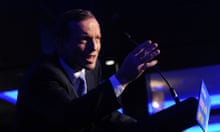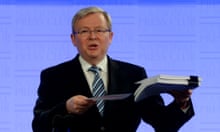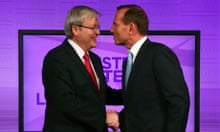How much does Australia spend on foreign aid?
In 2012, Australia reported spending $5.4bn (£3.2m) on official development assistance (ODA), making it the eighth-largest aid donor in the Organisation for Economic Co-operation and Development (OECD) group of rich countries, and just ahead of Sweden ($5.2bn). As a percentage of gross national income (GNI), Australia seems far less generous and was closer to reaching the international target to spend 0.7% of GNI on aid in the 1960s and 70s than it is today. Charities point out that foreign aid accounts for just 1.4% of Australia's federal budget and that it has suffered disproportionately from cuts and deferrals in recent years.
Where does the money go?
The bulk of Australian aid is focused on Asia and the Pacific, with Indonesia and Papua New Guinea the top two recipients. Last year the government announced it would spend A$375m of aid money on asylum-seekers in Australia instead of on overseas development projects. Critics pointed out that the decision would make Australia the third-largest recipient of its own foreign aid. However, while the announcement marked a significant change in Australia's approach, OECD rules allow donors to count some in-country refugee costs as ODA; several – including the Netherlands, Canada and Sweden – already do so. Australia reported zero in-country refugee costs as aid in 2011 and $5.5m in 2010.
Why has Australian aid been in the news recently?
Anti-poverty groups are up in arms over recent government decisions to delay planned increases to the aid budget and to divert more aid to PNG as part of prime minister Kevin Rudd's plan to send every asylum seeker who arrives in Australia by boat to PNG for processing and, possibly, resettlement. The government's August economic statement said costs associated with the plan would be "offset from a reduction in AusAid's budget" and that PNG would receive an extra A$420m in aid over four years, on top of the A$500m it receives each year. The Australian council for international development said the move went against the government's advice from its 2010 independent review, which found that PNG was not a good candidate for aid expansion. They also called for the cessation of using the foreign aid budget to pay for enacting asylum-seeker policies.
We are nearing an election – what are the parties' positions on aid?
Julie Bishop has said the Coalition's foreign policy focus will be on economic diplomacy, promoting the economic interests of Australia and Australian businesses. International engagement, including aid, would be led by the department of foreign affairs and trade. The goal of AusAid, said Bishop, should be to transform relationships between Australia and recipients of its aid into "sustainable economic partnerships", and a signature policy would be a plan to help Australian students live, study, and intern in the Asia and Pacific region. In its policy document Real Solutions, the Coalition says it will ensure future aid funding increases "are dependent on AusAid meeting strict performance benchmarks". Labor has said little about its aid and development priorities going into the election. "It could be some time after the election before it is clear what the incoming government will do with the aid programme," says Robin Davies, associate director of the Development Policy Centre at Australian National University. Picking priorities for the G20 development agenda, which Australia will lead from December 2013, will be an early task.
What is the government's record on aid?
The government earned praise in 2010 for commissioning the first independent review of Australia's aid programme in 15 years and for making AusAid an executive agency. The year before, the government overturned restrictions on spending aid money on sexual and reproductive health services, introduced under the previous administration. AusAid has also expanded Australian presence and aid programmes in Africa. In 2011, the country became the fourth major aid donor to publish data to the International Aid Transparency Intitiative (IATI) registry, after joining a founding member in 2008. More recently, however, critics have attacked the government's decision to push back planned budget increases and delay until 2017-18 plans to spend 0.5% of GNI on aid. Observers have questioned whether this is even possible as, under current plans, the aid budget would have to grow by A$2bn in 2017-18 alone. Earlier this month, the foreign minister, Bob Carr, told the Guardian there was no alternative to the delay in growth because of low government revenue. "You can't run a deficit to fund recurrent expenditure and foreign aid is recurrent expenditure," he said, adding that while the trajectory of budget increase has changed "we will reach the target on the same date." Since 2007, the goal of increasing spending to 0.5% of GNI has been delayed five times – twice in the target date and three times in trajectory.
Is Australia's aid tied?
In 2006, Australia "untied" most of its aid programme. Before, all Australian aid-funded contracts, for anything from textbooks to project management, had to go to domestic companies. Critics say tied aid – sometimes called boomerang aid – amounts to corporate welfare for companies in rich countries and undermines development overseas. However, even though most Australian aid contracts are formally untied and open to competition, the OECD notes that the majority still goes to Australian companies and that only a fraction of procurements are undertaken by recipient countries. In 2011, the government committed to developing stronger links between Australian businesses and the foreign aid programme and AusAid set up a special unit for domestic companies eyeing aid-funded business.
Who is Melissa Parke?
Last month, Melissa Parke was announced as Australia's new minister for international development, the first since 1996. Parke, a lawyer, has worked with the UN in Kosovo, Gaza, and New York and in 2006 travelled to Lebanon to help investigate the assassination of former prime minister Rafik Hariri. As Australian Labor party member for Fremantle, Western Australia, Parke has served on committees including foreign affairs, defence and trade, and the statutory committee on human rights. She has been a vocal critic of her government's asylum policies, as well as on live animal exports.










Comments (…)
Sign in or create your Guardian account to join the discussion